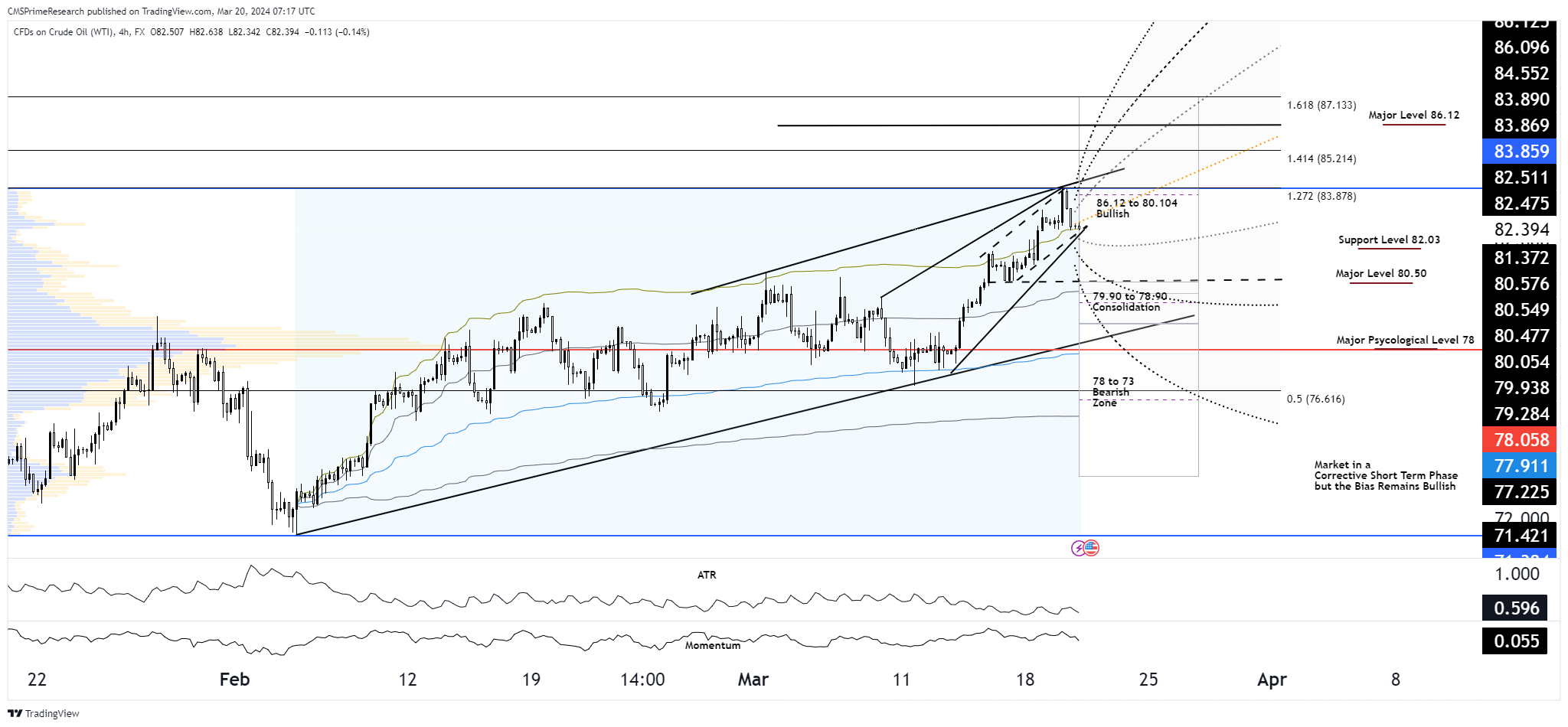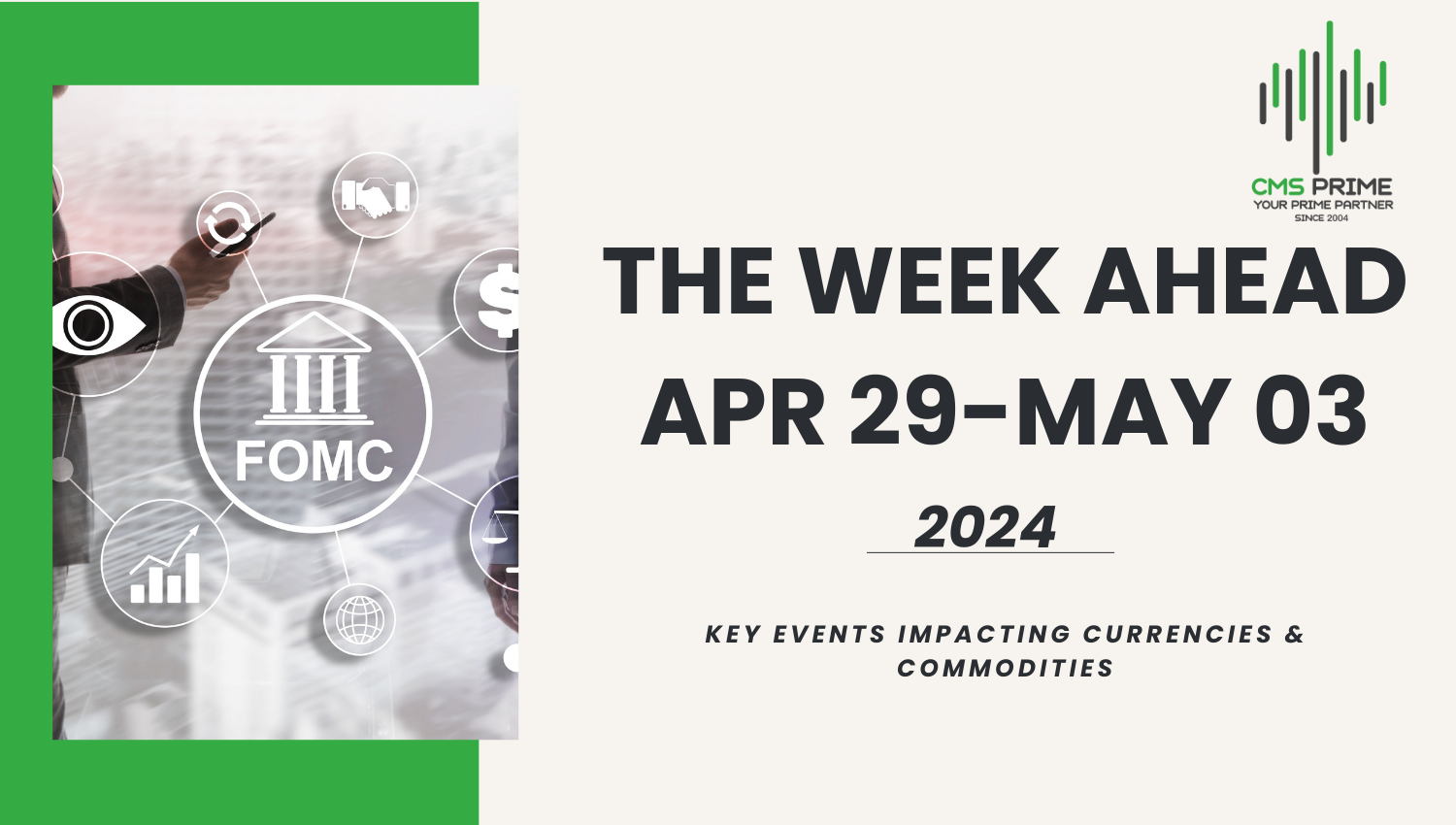
Current Factors Influencing Current Crude Oil Prices:
Early Asian trading saw a slight decline in oil prices as a stronger dollar and profit-taking activities weighed on investor interest, following recent multi-month highs in oil benchmarks.
Brent crude futures for May delivery dropped 17 cents, or 0.18%, to $87.17 a barrel, while U.S. West Texas Intermediate futures for April delivery fell 30 cents, or 0.36%, to $83.10 a barrel, ahead of Wednesday’s settlement.
The U.S. dollar index climbed higher for the fifth consecutive session, dampening Asian buyer sentiment, as recent data suggested resilience in the U.S. economy. A stronger dollar typically makes oil more expensive for investors using other currencies.
Both Brent and WTI reached their highest levels since late October in the previous session amid assessments of the impact of Ukrainian drone attacks on Russian refineries on crude and petroleum supplies.
Russian crude oil exports are expected to increase due to a drop in refining capacity caused by the strikes, according to trade sources. Exports from Russia’s western ports are projected to rise by nearly 260,000 barrels per day in March.
The American Petroleum Institute reported declines in U.S. crude oil and gasoline stockpiles last week, while distillate inventories saw an increase, contrary to analyst expectations of a rise in stocks.
Official stockpile data from the U.S. Energy Information Administration is scheduled for release on Wednesday.
The CERAWeek by S&P Global conference in Houston from March 17-22 will feature key energy executives and officials, including U.S. Secretary of Energy Jennifer Granholm, and CEOs from major oil producers like BP, Chevron, Exxon Mobil, Saudi Aramco, Sinopec, and Petronas.
Technical and Fundamental Analysis

Chart Overview and Price Action
Technical Analysis:
Current Trend: The chart indicates WTI is in a bullish trend within an ascending channel, with a recent pullback suggesting a short-term corrective phase. However, the primary trend remains bullish.
Support and Resistance Levels:
- Major Support Level: $82.03, which coincides with the lower boundary of the ascending channel.
- Major Resistance Level: $86.12, marked by the channel’s upper boundary and the recent high.
Fibonacci Levels: The retracement levels indicate potential support at $83.878 (1.272 extension) and $82.475 (1.414 extension). The major level to watch on the upside is $87.133 (1.618 extension).
Moving Averages: Price action is above the moving averages, reinforcing the overall bullish trend.
Momentum Indicators: The ATR indicates slightly increased volatility. However, the momentum remains positive but shows signs of deceleration as prices pull back from recent highs.
Fundamental Analysis:
Dollar Strength: The rising U.S. dollar index can exert short-term bearish pressure on oil prices due to higher costs for non-dollar investors.
Russian Supply: Increased Russian exports may temporarily increase supply, but refinery attacks and storage constraints could lead to output reductions, supporting prices in the mid to long term.
U.S. Stockpiles: Declining crude oil and gasoline stockpiles are bullish indicators, suggesting robust demand in the U.S. market.
Upcoming Events: The CERAWeek conference may reveal key insights into energy policies and producer strategies, potentially impacting market sentiment.
Scenario Forecasts:
Bullish Scenario (45% Probability): Continuation of the uptrend supported by tight global supplies and declining U.S. inventories.
- Price Targets:
- First Target: $84.15-$86.12 (resistance and channel top)
- Second Target: $87.133 (1.618 Fibonacci extension)
- Stretch Target: $88+ (on sustained bullish fundamentals)
- Price Targets:
Bearish Scenario (30% Probability): A stronger dollar and potential increase in Russian exports leading to a pullback.
- Price Targets:
- First Target: $82.03 (channel support)
- Second Target: $80.50 (psychological support)
- Stretch Target: $78 (major psychological level and below channel)
- Price Targets:
Neutral Scenario (25% Probability): Market consolidation ahead of CERAWeek conference and EIA data release.
- Price Targets: Range-bound between $82.03 and $86.12.
Overall Market Sentiment:
- Positive: 45% – Supported by OPEC’s positive demand outlook and declining U.S. stockpiles.
- Negative: 30% – Weighed down by the stronger dollar and potential short-term supply influx from Russia.
- Neutral: 25% – Market participants may adopt a wait-and-see approach pending upcoming industry events and data releases.
Price targets and sentiment are subject to change based on the evolving geopolitical situation, currency fluctuations, and new economic data. Market participants should remain vigilant to adapt to changing conditions.
Price analysis and Targets:($78-$86)
Taking into account the current bullish trend, potential for short-term bearish pullbacks due to a stronger dollar and increased Russian exports, and the anticipation of key events and data releases. Targeting the specified price ranges of $84.15-$86.12 for bullish movements and $80.50-$78.00 for bearish corrections. Below is a Strategy Framework.
Strategy Framework
Market Condition and Sentiment Analysis:
- With a 45% positive sentiment leaning towards continued bullish momentum, supported by tight global supplies and declining U.S. inventories, alongside a 30% cautionary perspective due to dollar strength and potential supply adjustments, strategic positioning is crucial.
Strategic Application for Target Price Points:
- Bullish Strategy for $84.15-$86.12 Target: Leverages the ascending channel trend and bullish fundamentals, preparing for a push towards upper channel resistance.
- Bearish Strategy for $80.50-$78.00 Target: Anticipates potential bearish retracements driven by the stronger dollar, increased Russian exports, and market reactions to upcoming data/events.
Execution Plan
Bullish Target ($84.15-$86.12):
- Entry Point: Initiate long positions upon signs of a rebound from the major support level at $82.03 or upon a breakout above $83.878, especially if bolstered by bullish fundamentals or positive outcomes from the CERAWeek conference.
- Stop-Loss: Set stop-loss orders just below the $82.03 support level to mitigate risks in case of a downward breach.
- Profit Targets: Aim for profits starting at $84.15, extending to $86.12, and be prepared to reassess targets if momentum pushes prices towards the $87.133 Fibonacci extension.
Bearish Target ($80.50-$78.00):
- Entry Point: Enter short positions if oil prices break below the $82.03 support, particularly if driven by a stronger dollar, bearish EIA inventory data, or negative sentiments from the CERAWeek conference.
- Stop-Loss: Place stop-loss orders slightly above the $82.475 (1.414 Fibonacci extension) to protect against a quick reversal to bullish momentum.
- Profit Targets: Set the primary profit target at $80.50, with a stretch goal of reaching $78.00, adjusting based on market response and bearish indicators.
Risk Management and Market Monitoring
- Position Sizing: Balance trade sizes based on the assessed probability of each scenario’s unfolding and individual risk tolerance. Given the bullish bias but acknowledged bearish risks, a cautious yet opportunistic approach is advised.
- Continuous Analysis: Stay vigilant for updates from the CERAWeek conference, U.S. dollar index movements, EIA inventory data, and other geopolitical developments that could impact oil prices, ready to swiftly adjust or exit positions based on new information.
- Sentiment Adjustment: Regularly reassess market sentiment, especially in response to forthcoming economic indicators and global energy policies, adapting the strategy to align with the evolving market landscape.
Conclusion
This strategy is designed to navigate the complexities of the crude oil market by exploiting identified bullish and bearish scenarios to target specified price points. By employing disciplined entry, stop-loss, and profit target mechanisms, and remaining adaptable to changes in economic indicators, geopolitical developments, and industry events, traders can seek to capitalize on the opportunities presented within the current market environment. Continuous engagement with market developments and sentiment analysis will be key to refining the approach as conditions evolve.
To know more about CMS Prime visit us at https://cmsprime.com
Disclaimer: This is not an Investment Advice. Investing and trading in currencies involve inherent risks. It’s essential to conduct thorough research and consider your risk tolerance before engaging in any financial activities.


